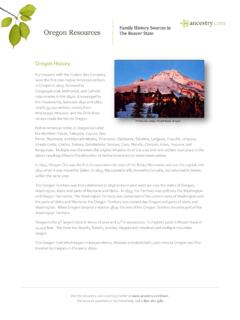Transcription of Major U.S. Immigration Ports Plus tips for locating your ...
1 Visit the Learning Center at For account questions or technical help, call 1-800-262-3787. Major Immigration Ports plus tips for locating your ancestors in arrival records The Port of New York The Largest Port Of the 5,400,000 people who arrived in the United States between 1820 and 1860, more than two-thirds entered at New York. By the 1850s, New York was receiving more than three-quarters of the national total of immigrants, and by the 1890s more than four-fifths. Although New York was the largest and most important portal, more than seventy other federal immigrant stations were located along the shores of the United States. Quarantine Prior to July 1855, there was no immigrant processing station at New York. Passengers and crew were inspected onboard by a health official and if any were infected with an infectious disease, all passengers and crew were sent to the Quarantine on Staten Island.
2 Built in 1799, the Quarantine was a compound of hospitals surrounded by six-foot high wall in Tompkinsville. From the start, the residents of Staten Island resented the Quarantine, blaming it for disease in the surrounding communities. In September of 1858, a mob burned down the hospitals. Following the blaze, the quarantine station was relocated to a large ship, the Florence Nightengale, which was anchored in the Atlantic Ocean. In 1866, the quarantine station was again relocated to Hoffman and Swinburne Islands, where it remained until moving to Ellis Island in 1920. In 1847, the Emigrant Refuge and Hospital on Ward s Island was built as a place of refuge for immigrants who were ill. It quickly grew to become the largest hospital complex in the world at that time. It was established by the Board of Commissioners of Emigration, who would in 1855 go on to establish the Emigrant Landing Depot at Castle Garden to aid immigrants upon arrival in New York.
3 Castle Garden In 1855, Castle Garden (sometimes called by its earlier name, Castle Clinton), an old fort on the lower tip of Manhattan, was designated as an immigrant station under the supervision of the State of New York. When a new federal law was passed in 1882, Castle Garden continued to operate under contract to the United States government. By 1890, however, the facilities at Our immigrant ancestors journey to America is an important part of the family story. They probably entered through any of the more than seventy federal immigrant stations located along the country s shores, the most famous of which was New York. In this guide we ve gathered interesting details you might not know about the Major Immigration Ports of New York, Philadelphia, Baltimore, Boston, Galveston, New Orleans, and San Francisco, as well as tips for finding your ancestor s arrival record.
4 Immigration Station, Ellis Island, New York, 1900. From the Library of Congress Photo Collection, 1840-2000 Visit the Learning Center at For account questions or technical help, call 1-800-262-3787. Major Immigration Ports plus tips for locating your ancestors in arrival records Castle Garden had long since proved to be inadequate for the ever-increasing number of immigrant arrivals. Ellis Island After a government survey of potential locations, Ellis Island was the site chosen for an entirely new United States Immigration station. Several Manhattan sites were previously rejected because earlier newcomers had been routinely and ruthlessly exploited as they left Castle Garden. On an island, the immigrants could be screened, protected, and filtered slowly into their new culture. From April 1890 through December 1891, a barge office near the Customs House at the foot of Manhattan served as the Immigration station and on 1 January 1892, the Ellis Island Immigration Station was opened.
5 The life of the first station on Ellis Island was short. All the pine-frame buildings burned to the ground in a disastrous fire on 15 June 1897. Congress immediately appropriated funds to replace the structures with fireproof buildings. During the next two and a half years, immigrants were once again processed at the barge office on Manhattan. The new buildings were brick and ironwork structures with limestone trimmings, and the station reopened 17 December 1900. The main building was notable for its cupola-style towers and spacious second-floor Registry Room. Immigration Quotas Soon after the 1924 Immigration Act was adopted, traffic through Ellis Island subsided to a trickle. A final revision of the "national origins" quota system went into effect in 1929. The maximum number of all admissions to the United States was reduced to only 150,000 people annually and was a deliberate attempt to set permanently the ethnic and racial mix of America.
6 These Immigration restrictions dealt a deathblow to the importance of Ellis Island. In its last years of operation, a portion of the island was used as a Coast Guard station and later as a detention center for enemy aliens. In November 1954, the last immigrant and the last detainee left, and the Immigration center was declared surplus property by the General Services Administration (GSA). City of New York, 1856. (Castle Garden at the bottom left). Sketched and drawn on stone City of New York, 1856. (Castle Garden at the bottom left.) Sketched and drawn on stone by C. Parsons (Currier & Ives). From the Map Collection, 1513-1990 on Ancestry. Visit the Learning Center at For account questions or technical help, call 1-800-262-3787. Major Immigration Ports plus tips for locating your ancestors in arrival records The Port of Philadelphia Geography Located more than 100 miles from the Atlantic Ocean, Philadelphia would seem an unlikely candidate as a Major Immigration port of entry, but million immigrants passed through the port.
7 The route took immigrants around Cape May at the foot of New Jersey, into Delaware Bay and up the Delaware River to Philadelphia, adding more than 200 miles to the journey from Europe. And the route wasn t without its hazards. The Delaware River often froze over during winter, limiting early Immigration to warmer months. The Immigrants During the 1700s, there was an influx of German and Scots-Irish immigrants, many of whom arrived as indentured servants or redemptioners and stayed in the city to work off the cost of the passage. Between 1847 and 1854, the port of Philadelphia ranked 4th in terms of Immigration , receiving percent of immigrants arriving in America. By 1870, more than 25 percent of the city s 750,000 residents were foreign, with 100,000 Irish and 50,000 Germans comprising the majority of the immigrant population and English and Scottish immigrants accounting for much of the remainder.
8 Beginning in the 1880s, Philadelphia s immigrant population became more diverse, with significant populations of Italians, Hungarians, Poles, and Russian and Eastern European Jews (particularly following the pogroms that were carried out in the early 1880s and 1900s) entering the mix. While earlier Immigration groups were spread out throughout the city and surrounding areas, these newer groups tended to settle in ethnic enclaves. Between 1880 and 1900, Philadelphia was the port of entry for percent of immigrants, but between 1910 and the advent of World War I in 1914 that dropped to percent. The quotas set in 1924 put the brakes on Immigration , particularly from southern and eastern European countries and in the post-World War I era, less than 1 percent of the nation s immigrants passed through the Philadelphia s port.
9 The Lazaretto Spurred by the 1793 yellow fever epidemic in Philadelphia, in 1799 the Lazaretto quarantine station was built 8 miles from the city. Ships were required to stop there for health inspections. The hospital had the capacity to house 500 patients. Infected clothing and bags could be disinfected by steam. In 1884 a federal quarantine station was also set up on Reedy Island whereby passengers received screenings from both state and federal authorities. The duplicate screenings were ended in 1913 when a centralized inspection station opened at Marcus Hook, 20 miles from Philadelphia. Lazaretto Quarantine Station, Delaware River, Tinicum Township, Delaware County, Pennsylvania, 1933. From the Library of Congress Photo Collection, 1840-2000 Visit the Learning Center at For account questions or technical help, call 1-800-262-3787.
10 Major Immigration Ports plus tips for locating your ancestors in arrival records Despite the multiple inspections, Philadelphia didn t turn away many immigrants. According to Forgotten Doors: The Other Ports of Entry to the United States, by M. Mark Stolarik, From 1901 to 1902, for example, of 17,175 arrivals in Philadelphia, though many were detained for questioning or investigation, only 107 were debarred from entering the country. Only 26 of these were due to disease. Immigration Stations In the 50 years following 1873, in which the Red Star and American steamship lines began regular service, more than 1 million immigrants arrived at Philadelphia immigrant stations where they went through Customs. The Washington Avenue station where those two lines docked was especially busy. The Pennsylvania Railroad built an immigrant station on the wharves to receive the immigrants.












